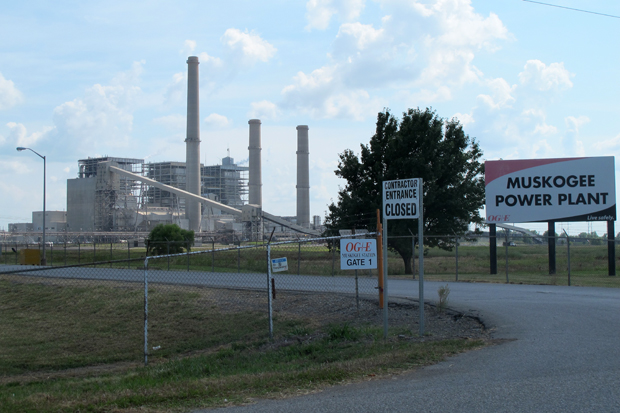
Oklahoma Gas & Electric's Muskogee Power Plant.
Logan Layden / StateImpact Oklahoma


Oklahoma Gas & Electric's Muskogee Power Plant.
Logan Layden / StateImpact Oklahoma
The U.S. Environmental Protection agency on Monday announced an ambitious plan to reduce carbon dioxide emissions at existing coal-fired power plants across the country as part of President Barack Obama’s push to curb climate change.
Oklahoma Attorney General Scott Pruitt blasted the move, saying in a statement the plan “has no legal basis or the force of law.”
“It will undoubtedly lead to higher electricity rates, job losses and increased manufacturing costs as coal-fired power plants, which provide 40 percent of our baseload power, are taken offline,” Pruitt says.
But officials with the Sierra Club’s Beyond Coal Campaign in Oklahoma says keeping the current rules unchanged will be more costly because communities are already paying to deal with carbon pollution-fueled “climate disruption,” like flooding, wildfires and extreme heat.
“Cutting pollution that harms our communities will also save billions of dollars in health costs, disaster cleanup, and disaster recovery costs,” the campaign’s Whitney Pearson said in a statement.
The proposed rule sets the goal of reducing U.S. CO2 emissions by 30 percent compared to the 2005 baseline by 2030.
The proposal sets off a complex regulatory process, steeped in politics, in which the 50 states will each determine how to meet customized targets set by the Environmental Protection Agency.
Options for states to meet the targets include making power plants more efficient, reducing the frequency at which coal-fired power plants supply power to the grid, and investing in more renewable, low-carbon sources of energy.
It will be up to states how, exactly, to reduce CO2 emissions, but one way would be to implement cap and trade policies like the ones in California and the northeastern U.S. Attorney General Scott Pruitt said in a May 29 statement that was the ultimate goal of the EPA.
“The Clean Air Act clearly sets out a role for EPA to suggest guidelines, while granting states authority to develop and implement specific proposals to achieve the goals of the Clean Air Act,” says. “Should the EPA’s proposed regulation force states to adopt a ‘cap and trade’ scheme or any other specific proposal, it would violate the law and likely be challenged in court.”
He worries the Obama administration’s treatment of the coal industry is a precursor for a coming push against the oil and gas industry.
Monday’s announcement from the EPA is big news, but it’s important to note that it could be years before these proposed rules go into effect. They won’t be finalized until next year, after a public comment period that started today. After that, states will have a chance to implement their own plans for meeting their emissions reduction goal.
If a state’s plan isn’t adequate, or if the rules are challenged in court as violations of the Clean Air Act, the process could drag on even longer. And if that sounds familiar, it’s because it is. As StateImpact has reported, the EPA’s regional haze rule — also an offspring of the Clean Air Act — has been through a very similar process since it was first announced in 1999.